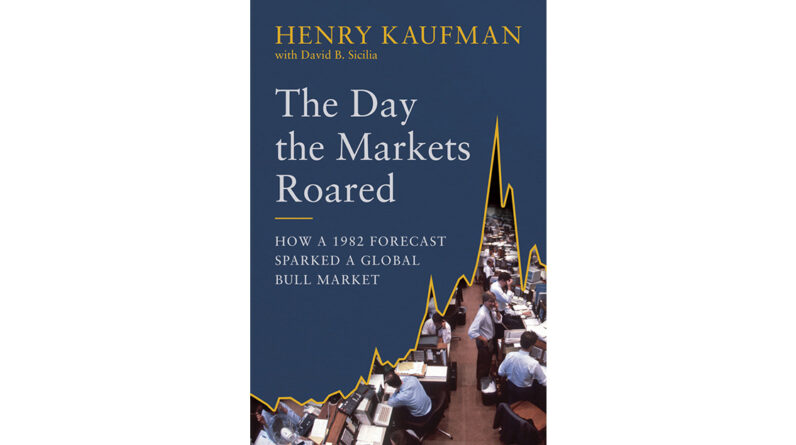
The Day the Markets Roared: How a 1982 Forecast Sparked a Global Bull Market. 2021. Henry Kaufman with David B. Sicilia. Matt Holt Books.
The title of Henry Kaufman’s latest book focuses on a single date, 17 August 1982, but the contents range far more widely. Kaufman recounts his personal history, from fleeing Nazi terror with his family in 1937 at age nine to his years as head of research at Salomon Brothers. Near the volume’s conclusion, he discusses the market impact of the COVID-19 pandemic.
Writing in collaboration with University of Maryland business historian David Sicilia, Kaufman shows that he was an innovator in the analysis of financial markets, highlighted by his pioneering use of flow-of-funds data to generate interest rate forecasts.
Interspersed with this narrative, Kaufman argues that Wall Street’s shift from partnerships to corporations undermined research independence. He also laments the increased concentration of the US financial industry. Between 1990 and 2000, he reports, the proportion of financial assets held by the 10 largest financial institutions jumped from approximately 10% to at least 80%. Other trends that concern him include declining corporate credit quality and the widespread redefinition of liquidity from holding assets that are readily convertible into cash to having the capacity to borrow. Along the way comes some score settling with the late Salomon Brothers chairman John Gutfreund, plus a prediction that the rating agencies will downgrade the US government.
The book’s centerpiece, however, is a recap of the day that Henry Kaufman triggered what was at the time the biggest ever one-day rise in the S&P 500 Index and the DJIA by revising his interest rate outlook. Before that event, he had been dubbed “America’s Interest Rate Guru” by Institutional Investor and “Dr. Doom,” apparently by the New York Post, which Kaufman describes as “designed for those without the patience to wade through one of the more substantial papers.” The first nickname recognized his immense influence among institutional investors, while the latter mocked him for adamantly sticking to his view that burgeoning federal deficits would continue driving interest rates higher. His resoluteness also resulted in death threats. Kaufman’s name was found on a list of prominent individuals evidently targeted for assassination by a terrorist arrested by the FBI.
As Kaufman freely acknowledges, the trend in interest rates had already turned positive 10 months before his reversal made the markets roar. No other news of 17 August 1982 could account for that day’s spectacular rally. Prices essentially soared based on nothing that qualified as information, as strictly defined by financial economists. The only thing that changed was one man’s opinion of previously known facts.1 In short, the event qualifies as an efficient market hypothesis (EMH) anomaly.2
Die-hard EMH adherents might comfort themselves with the thought that this all took place four decades ago and could not possibly occur today. Kaufman implies as much:
“The way economic and investment information reaches Wall Street has already changed considerably over the last forty years, which may be yet another reason why no private-sector individual since has caused the markets to roar (or collapse) to the same degree.”
At the individual security level, however, it is commonplace even now for prices to move on nothing that could be construed as new fundamental information but instead in response to individuals’ revised interpretations of previously disseminated information. To cite a representative example, on 25 March 2021, the price of Cisco Systems (CSCO) shares jumped by 1.7%, while the major stock indexes rose by just 0.1%–0.6% and tech shares lagged. Multiple news outlets attributed CSCO’s outperformance to an upgrade from Hold to Buy by Goldman Sachs analyst Rod Hall. At least one reporter also noted that Evercore ISI raised its CSCO target price from $54 to $58, but this reviewer has found no article that cited any event of 25 March 2021 that promised to increase the company’s future earnings.
Rarely does a book appear that contains not a single inaccuracy. The Day the Markets Roared mistakenly includes Ayn Rand, who came to the United States in 1926, among the “European intellectuals . . . who emigrated to the United States during or after the Second World War.” In addition, the text variously refers to a past US Federal Reserve chairman as “banker G. William Miller” and (correctly) “businessman G. William Miller.” (The onetime Textron CEO, by the way, began his career as a lawyer.)
Despite the book’s minor flaws, investment professionals can
profit from this page-turner’s 60-plus-year perspective on financial markets. As a bonus, the book provides an insider’s view of Wall Street history, a noteworthy philanthropic interest of Kaufman’s. Especially enjoyable are the affectionate portraits of his illustrious mentors and fellow Salomon Brothers partners, as well as a full chapter devoted to his First Boston counterpart and friend Albert “Dr.
Death” Wojnilower.
1. Even more remarkably, approximately a month before the day the market roared, the New York Daily News reported that a rumor that Kaufman had revised his interest rate outlook triggered a one-day rally.
2. In “Do Brokerage Analysts’ Recommendations Have Investment Value?” Kent L. Womack summarized thus the argument presented earlier by Sanford Grossman and Joseph Stiglitz: “Information is costly to process. Brokerage firms spend hundreds of millions of dollars annually analyzing stocks and trying to persuade investors that certain stocks are more or less attractive than others. . . . Market prices cannot perfectly reflect all available information, or else information gatherers would earn no compensation for their costly activities.”
If you liked this post, don’t forget to subscribe to the Enterprising Investor.
All posts are the opinion of the author. As such, they should not be construed as investment advice, nor do the opinions expressed necessarily reflect the views of CFA Institute or the author’s employer.
Professional Learning for CFA Institute Members
CFA Institute members are empowered to self-determine and self-report professional learning (PL) credits earned, including content on Enterprising Investor. Members can record credits easily using their online PL tracker.









